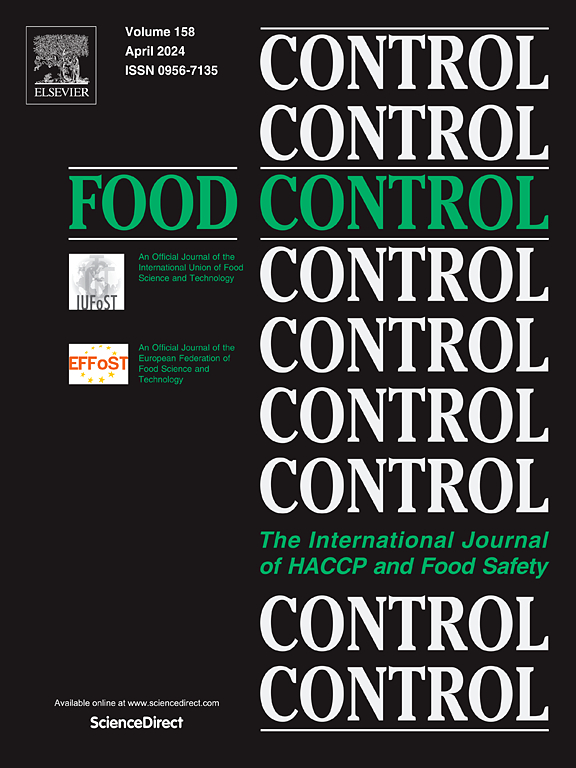Electrochemical RNA-based aptasensor for neomycin detection in milk samples
IF 5.6
1区 农林科学
Q1 FOOD SCIENCE & TECHNOLOGY
引用次数: 0
Abstract
Mastitis is one of the most common diseases in dairy cattle, leading to significant financial losses. Veterinary drugs containing neomycin (Neo) are frequently used to treat this condition. However, the overuse of neomycin results in antibiotic residues in milk, increased microorganism resistance, and reduced therapeutic efficacy. Therefore, there is a growing need for simple and cost-effective methods of neomycin detection. This study presents the development of an electrochemical aptasensor for neomycin detection in cow's milk. A 2′-O-methylated ssRNA aptamer (APT_Neo) was used as the receptor element and was covalently immobilized on the surface of the gold electrode alongside an anti-adhesive compound, 4-mercaptophenol (4-MCP). The interaction between neomycin and the 2′-O-methylated ssRNA aptamer was monitored through changes in the electron transfer resistance (ΔR) of the electrode, recorded using electrochemical impedance spectroscopy (EIS) in the presence of an electroactive label redox couple, Fe(CN)63−/4- in the supporting solution. The developed electrochemical aptasensor exhibits high sensitivity and a low detection limit (36.3 nM in a 10-fold-diluted cow's milk sample), and selectivity for neomycin over structurally similar compounds (kanamycin and streptomycin) as well as antibiotics from tetracycline group (tetracycline and oxytetracycline). The proposed aptasensor is user-friendly and scalable, paving the way for the development of innovative miniaturized electrochemical sensor systems for practical applications in neomycin detection in cow's milk samples and food safety monitoring.
基于电化学rna的配体传感器检测牛奶样品中的新霉素
乳腺炎是奶牛最常见的疾病之一,导致重大的经济损失。含有新霉素(Neo)的兽药常用于治疗这种疾病。然而,过度使用新霉素会导致牛奶中的抗生素残留,增加微生物耐药性,降低治疗效果。因此,人们越来越需要一种简单、经济的新霉素检测方法。本文介绍了一种用于牛奶中新霉素检测的电化学感应传感器的研制。2 ' - o -甲基化的ssRNA适配体(APT_Neo)作为受体元件,与抗粘附化合物4-巯基苯酚(4-MCP)共价固定在金电极表面。通过电极的电子传递电阻(ΔR)的变化来监测新霉素与2 ' - o -甲基化ssRNA适体之间的相互作用,使用电化学阻抗谱(EIS)记录在电活性标记氧化还原对Fe(CN)63−/4-存在的支持溶液中。所开发的电化学配体传感器具有高灵敏度和低检出限(在10倍稀释的牛奶样品中为36.3 nM),并且对新霉素的选择性优于结构相似的化合物(卡那霉素和链霉素)以及四环素类抗生素(四环素和土霉素)。该传感器具有用户友好性和可扩展性,为开发创新的小型化电化学传感器系统铺平了道路,可用于牛奶样品中新霉素的检测和食品安全监测。
本文章由计算机程序翻译,如有差异,请以英文原文为准。
求助全文
约1分钟内获得全文
求助全文
来源期刊

Food Control
工程技术-食品科技
CiteScore
12.20
自引率
6.70%
发文量
758
审稿时长
33 days
期刊介绍:
Food Control is an international journal that provides essential information for those involved in food safety and process control.
Food Control covers the below areas that relate to food process control or to food safety of human foods:
• Microbial food safety and antimicrobial systems
• Mycotoxins
• Hazard analysis, HACCP and food safety objectives
• Risk assessment, including microbial and chemical hazards
• Quality assurance
• Good manufacturing practices
• Food process systems design and control
• Food Packaging technology and materials in contact with foods
• Rapid methods of analysis and detection, including sensor technology
• Codes of practice, legislation and international harmonization
• Consumer issues
• Education, training and research needs.
The scope of Food Control is comprehensive and includes original research papers, authoritative reviews, short communications, comment articles that report on new developments in food control, and position papers.
 求助内容:
求助内容: 应助结果提醒方式:
应助结果提醒方式:


